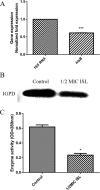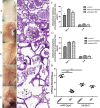In vitro activity and In vivo efficacy of Isoliquiritigenin against Staphylococcus xylosus ATCC 700404 by IGPD target
- PMID: 31860659
- PMCID: PMC6924684
- DOI: 10.1371/journal.pone.0226260
In vitro activity and In vivo efficacy of Isoliquiritigenin against Staphylococcus xylosus ATCC 700404 by IGPD target
Abstract
Staphylococcus xylosus (S. xylosus) is a type of coagulase-negative Staphylococcus, which was previously considered as non-pathogenic. However, recent studies have linked it with cases of mastitis in cows. Isoliquiritigenin (ISL) is a bioactive compound with pharmacological functions including antibacterial activity. In this study, we evaluated the effect of ISL on S. xylosus in vitro and in vivo. The MIC of ISL against S. xylosus was 80 μg/mL. It was observed that sub-MICs of ISL (1/2MIC, 1/4MIC, 1/8MIC) significantly inhibited the formation of S. xylosus biofilm in vitro. Previous studies have observed that inhibiting imidazole glycerol phosphate dehydratase (IGPD) concomitantly inhibited biofilm formation in S. xylosus. So, we designed experiments to target the formation of IGPD or inhibits its activities in S. xylosus ATCC 700404. The results indicated that the activity of IGPD and its histidine content decreased significantly under 1/2 MIC (40 μg/mL) ISL, and the expression of IGPD gene (hisB) and IGPD protein was significantly down-regulated. Furthermore, Bio-layer interferometry experiments showed that ISL directly interacted with IGPD protein (with strong affinity; KD = 234 μM). In addition, molecular docking was used to predict the binding mode of ISL and IGPD. In vivo tests revealed that, ISL significantly reduced TNF-α and IL-6 levels, mitigated the destruction of the mammary glands and reversed the production of inflammatory cells in mice. The results of the study suggest that, ISL may inhibit S. xylosus growth by acting on IGPD, which can be used as a target protein to treat infections caused by S. xylosus.
Conflict of interest statement
The authors have declared that no competing interests exist.
Figures








References
-
- Klimiene I, Virgailis M, Pavilonis A, Siugzdiniene R, Mockeliunas R, Ruzauskas M. Phenotypical and genotypical antimicrobial resistance of coagulase-negative staphylococci isolated from cow mastitis. Polish Journal of Veterinary Sciences. 2016;19(3):639–46. 10.1515/pjvs-2016-0080 WOS:000383528400024. - DOI - PubMed
-
- Bochniarz M, Zdzisinska B, Wawron W, Szczubial M, Dabrowski R. Milk and serum IL-4, IL-6, IL-10, and amyloid A concentrations in cows with subclinical mastitis caused by coagulase-negative staphylococci. Journal of Dairy Science. 2017;100(12):9674–80. 10.3168/jds.2017-13552 WOS:000415926900017. - DOI - PubMed
Publication types
MeSH terms
Substances
Supplementary concepts
LinkOut - more resources
Full Text Sources
Medical

